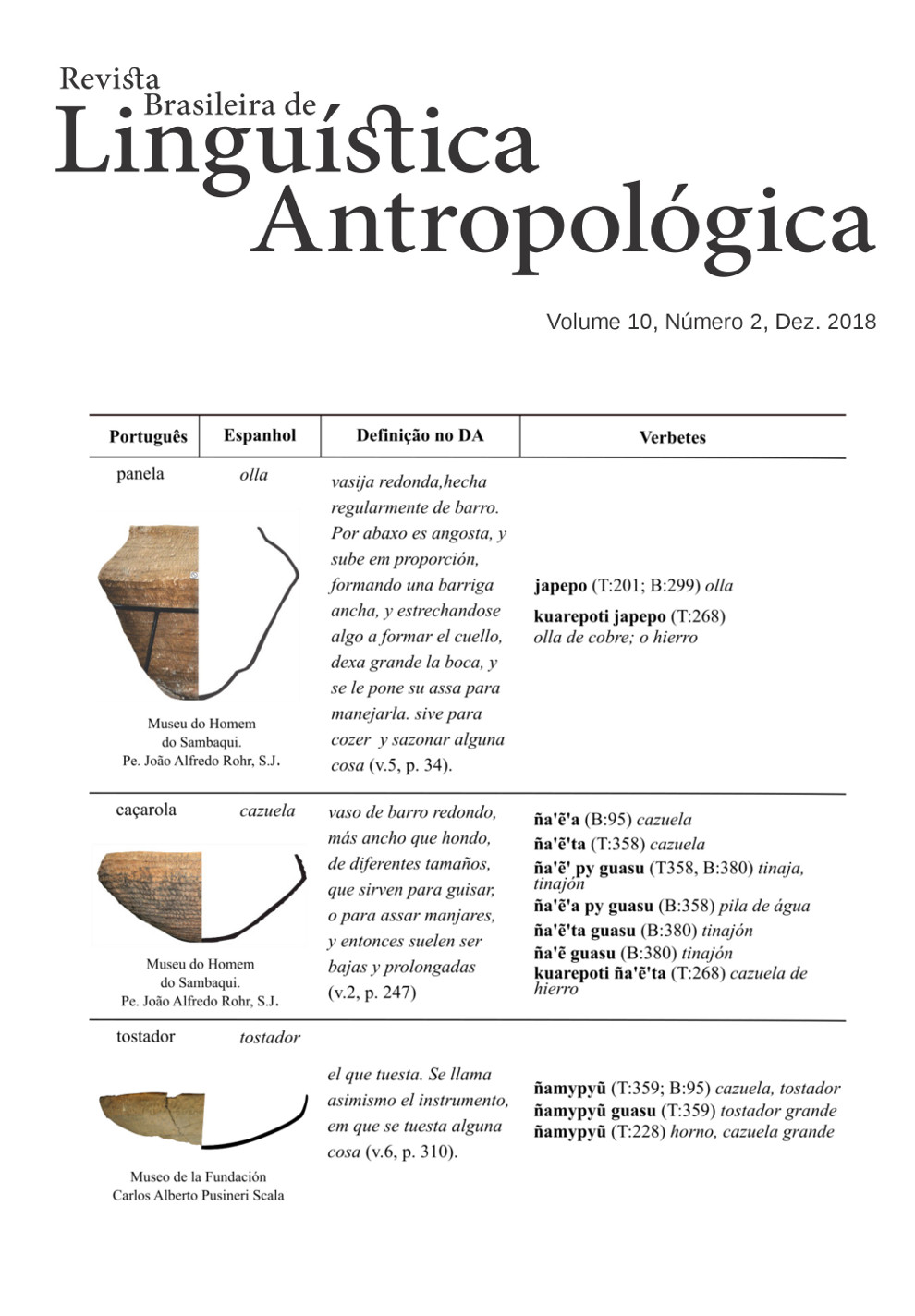Nonverbal Predicates In Tuparí
DOI:
https://doi.org/10.26512/rbla.v10i2.20941Keywords:
Non-verbal predicates. Nouns and adjectives. Copulas. Posicional verbs. Postposicional phrases.Abstract
The types of nonverbal predicates identified so far in the Tupari language, a language belonging to the Tupari family of the Tupi stok (Rodrigues 1964, 1984-85, 1986) are described. The analysis was based on the Tuparí data contained in Rodrigues and Caspar (1957), in Alves (2004), and new data collected in Brasília, in 2013 in Ji-Paraná, in 2016 in Brasília, and in 2017 and 2018 in Rio Branco Indigenous Land. The analysis is based on the typologies of predicates proposed by Payne (1997) and Dryer (2007). The article contributes with the linguistic studies on the Tuparí language, addressing a subject that is still very little studied in that language.
Downloads
References
Alves, Poliana Maria. 1991. Análise Fonológica Preliminar da Língua Tuparí. Dissertação de Mestrado, UnB.
Alves, Poliana M.. 2000. A Flexão Relacional em Tuparí. In: Anais da 52ª Reunião Anual da SBPC, Brasília, 2000, Brasília.
Alves, Poliana M.. 2001. Flexão Relacional em Tuparí e em Tupí-Guaraní. In: Línguas Indígenas Brasileiras: Fonologia, Gramática e História. Belém: Editora Universitária - EDUFPA/Livraria do Campus,. v. I. p. 269-273.
Alves, Poliana Maria. O léxico do Tuparí: proposta de um dicionário bilíngüe. (Tese de Doutorado). Universidade Estadual Paulista, Araraquara, 2004.
Alves, Poliana M.. 2007. O Dicionário Tuparí-Português. In: Ana Suelly Arruda Câmara Cabral; Aryon Dall’Igna Rodrigues. (Org.). Línguas e Culturas Tupí. 1ed.Campinas: Curt Nimuendajú, v. I, p. 301-308.
Caspar, Franz. 2015. Os Tupari. Uma tribo indígena no Brasil ocidental.. (MS).
Caspar, Franz, and Aryon Dall’Igna Rodrigues. 1957. Ms.Versuch einer Grammatik der Tuparí-Sprache.
Dryer, Matthew. 2007. Clause Types. In. Shopen Timothy, Language Typology and Syntactic Description, secon edition, Vol. I: Clause Structure. Edited by, Published in the United States of America by Cambridge University Press, New York.
Payne, Thomas E. 1997. Describing morphosyntax, A guide for field linguists. University of Oregon and Summer Institute of Linguistics, CAMBRIDGE UNIVERSITY PRESS, Cambridge, New York, Melbourne, Madrid, Cape Town, Singapore, Sao Paulo ( 63-65)
Rodrigues, Aryon; Caspar, Fraz. 2017. Esboço da Gramática da Língua Tuparí. Tradução de Enrique Huelvaa Unterbaum, Laura Waagerle, Ariel Pheula do Couto e Silva, Ana Suelly Arruda Camaara Cabral, Brasila, DF: lALLI-IL-UnB,.
Seki, L. 2002. Aspectos morfossintáticos do Nome em Tupari. In: Ana Suelly A. C. Cabral; Aryon D. Rodrigues. (Org.). Atas do I Encontro Internacional do Grupo de Trabalho sobre Línguas Indígenas da ANPOLL. 1ed. Pará: Editora Universitária UFPA, 2002, v. 1, p. 298-308.
Tupari, Raul Pat’ Aware. 2015. Ote Ma’ẽ - Reflexões Sobre a Escrita da Língua Tupari. Monografia, Licenciatura em Educação Básica Intercultural, Departamento de Educação Intercultural, Universidade Federal de Rondonia- UNIR.
Downloads
Published
How to Cite
Issue
Section
License
Copyright (c) 2018 Revista Brasileira de Linguística Antropológica

This work is licensed under a Creative Commons Attribution 4.0 International License.
Authors who publish in RBLA agree to the following terms:
a) Authors maintain the copyright and grant the journal the right of first publication, and the work is simultaneously licensed under the Creative Commons Attribution License, which allows the sharing of the work with recognition of the authorship of the work and initial publication in this journal.
b) Authors are authorized to assume additional contracts separately, for non-exclusive distribution of the version of the work published in this journal (eg, publish in an institutional repository or as a book chapter), with recognition of authorship and initial publication in this journal.
c) Authors are allowed and encouraged to publish their work online (eg, in institutional repositories or on their personal page) at any point before or during the editorial process, as this can generate productive changes, as well as increase impact and citation of the published work.







